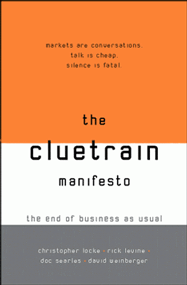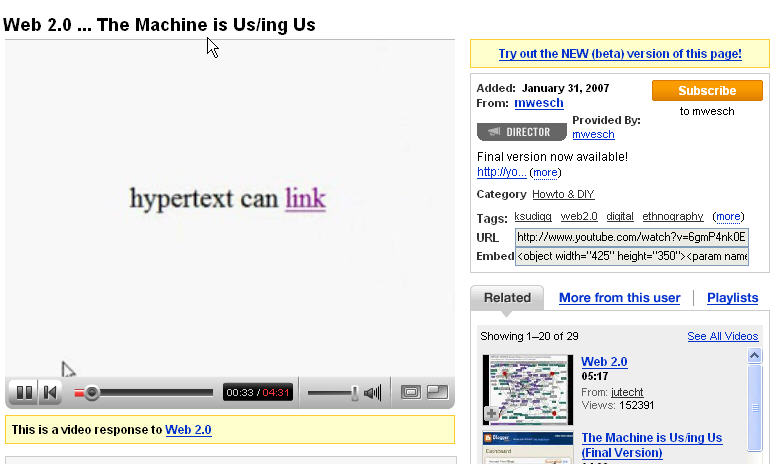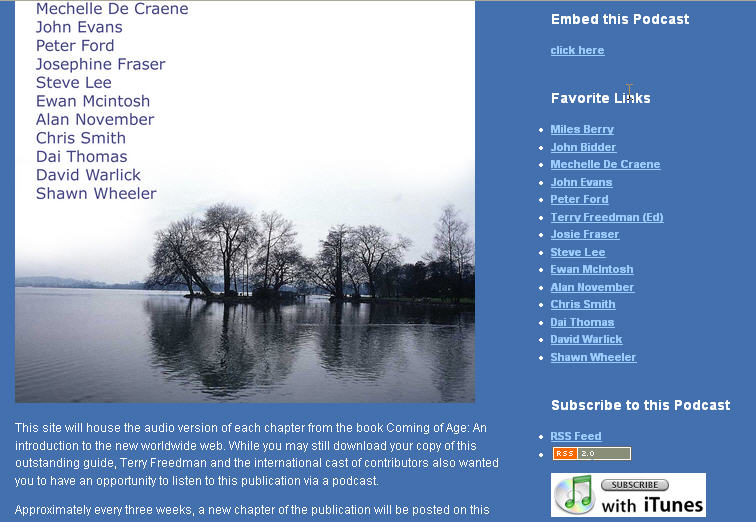About Vance |
CALL resources main page
& Site Index |
Vance's papers and
presentations
Back to the home page of this
presentation | Forward to Aggregation of
knowledge in distributed learning networks
Mastering competencies for
collaboration and aggregation in distributed learning networks
by Vance Stevens
Department of Computing, The Petroleum Institute, Abu Dhabi,
UAE
Web 2.0: Impacts on multiliteracies
in education
|
The read-write society in the 21st
century
Lawrence Lessig refers to the 20th century as the read only
century, i.e. a time when web pages were static, one way conveyors of
information, and top down disseminators of knowledge ("The 20th century was the
only read-only century in human history, totalitarian, centralizing,
controlling. The 21st is the return to read-write." Lessig (2006)). The "read-write society" is what he
says we are returning to in this century thanks to the increasingly
conversational nature of interaction available through the Internet today.
|

(Locke et al.,
2001)
|
The web's aknowledged creator, Tim Berners-Lee, might take issue with
that. When asked by Scott Laningham, host of DeveloperWorks podcasts: "You
know, with Web 2.0, a common explanation out there is Web 1.0 was about
connecting computers and making information available; and Web 2 is about
connecting people and facilitating new kinds of collaboration. Is that how you
see Web 2.0?" Berners-Lee replied: "Totally not. Web 1.0 was all about
connecting people. It was an interactive space, and I think Web 2.0 is, of
course, a piece of jargon, nobody even knows what it means. If Web 2.0 for you
is blogs and wikis, then that is people to people. But that was what the Web
was supposed to be all along." Laningham
(2006).
Despite the clear intent of its inventor, it is only now that his vision
is being universally implemented, which might account for the wide acceptance
of Tim O'Rielly's (2005) creation of the term Web
2.0 to denote the transformation of the web from a time of static web pages
designed to be consumed passively -- into a Web rich in interactions among
users. Indeed the Internet now offers a plethora of tools shared at web sites
which allow users to create or upload their own web artifacts which are most
often hosted on the site, for free and seemingly forever. There are hundreds if
not thousands of such sites and tools, and they have significant impact on
learning when they enourage students to be reflective while being interactive.
These two play on one another - students find an audience for their
reflections, encouraging them to reflect more and alter their output. Deeper
more profound reflecton attracts a wider audience, who in turn engage in
self-reflection as this becomes influenced by the reflections of others, and so
on. The tools available such as blogs, wikis, and Google docs, tend to support
the process of developing ideas, particularly through collaboration online. (Sessums 2007). The read/write Web 2.0 has become an
excellent vehicle for linking students in constructivist learning endeavors
taking advantage of the connectivist tendencies of distributed learning
networks.
The following video has become very popular because it illustrates this
pleasantly and succinctly in modernly multiliterate terms. One of its points is
that the Web operates off metadata, so that when we tag items, we teach the
machine, billions of times a day, to help us find information and connect with
others associating themselves with similar tags.

http://youtube.com/watch?v=NLlGopyXT_g
(Final Version)
There is a transcript of this video on the Kansas State
University, Dept. of Cultural Anthropology, Digital Ethnography blog:
http://mediatedcultures.net/ksudigg/?p=78
as well as at many other locations on the Internet.
In most good web sites today, there are numerous ways you can interact.
You can leave a comment, take a poll, rate the site, review it, you can even
subscribe to a service that tells you who else is on the site at the same time
you are and contact them. You are not limited to doing this on other people's
sites - you can make your own. You can easily set up your own web presence on
other people's servers, for free, and they're falling over themselves to
attract your participation. Once there you can upload or create text and
augment it with digital graphics, audio, or video which you might upload or
create on the site. Back in the read only century, you had to know some HTML,
you had to arrange your own web hosting, usually had to pay for it, and
bandwidth and the amount of space available seriously restricted where you
could park your large files. Nowadays, I upload large sound files to Podomatic
or Wikispaces just to give them a url so I can use them at other websites. For
video there are many fine services like blip.tv, Google Video, and YouTube that
will not only give your videos a home on the web but give you the script to
embed their players in your blogs and web pages.
A young generation of computer users is taking for granted that there
will always be such tools at their fingertips. Digital immigrants and digital
natives are how Marc Prensky (2001) divides the
world of computer users. Digital natives grew up with computers and technology.
Digital immigrants were raised in the good old days of snail mail and long
distance phone calls and do not necessarily find technology to be second
nature. Texting, instant messaging and MySpace are ways of communicating that
appeal to digital natives, who work at what has been called twitch speed (Prensky, 1998; Katz, 2000), and
for whom technology is "always on". If you are a digital native, then you
probably don't remember how things were in the read-only century.

Multiliteracies
Digital natives and immigrants, blogs, Twitter, Second Life, Breeze,
etc. illustrate where many of us are coming from in the means we use of
communicating with one another. Writing in the traditional sense is a skill
that will always be required, but its importance as a component in our means of
communication has diminished. For a long time writing was the sole means of
communication apart from speaking, and certainly it was for a long time the
only way to preserve what we wished to record (aside from art and music). It
remains true that an ability to write well is important and even crucial to the
art of conveying ideas today, but the role of text in what we convey in digital
format is no longer the only skill we have to master in order to communicate
effectively throughout an online distributed knowledge network. (Lorenzo, Oblinger, and Dziuban, 2004)
Nowadays, after several centuries where print literacy was what was
understood by the term 'literacy', educators are starting to think in terms of
'multiliteracies' (Unsworth, 2001). Multiliteracies
was a term coined by the New London Group in 1996.
Multiliteracies means literacy skills that help people communicate meaningfully
in the media available to all parties in the conversations taking place with
regard to that communication. Multiliteracies has many dimensions to it;
Selber (2004) for example breaks the concept into its
functional, rhetorical, and critical aspects, which basically means that to be
multiliterate you must use technology fluidly, to the point where you use it
comfortably, seamlessly, rather than let it control you, you know how to
communicate with others about how you use, develop, and repair technology, and
you are able to understand and articulate the many impacts of technology on our
lives and those of others in other walks of life and economic strata.
You might also like to look at what I've written on the topic in
TESL-EJ: Stevens 2005 and 2006, and in my blog, Stevens
2007.
There are many interesting examples of how communication takes place
among people whose muliliteracy skills are well developed; e.g. the interesting
Commoncraft video series by Lee and Sachi LeFever); on RSS, for example:
http://www.commoncraft.com/rss_plain_english,
or the I Generation Fan Video at
http://www.youtube.com/watch?v=eaQr9zXSY84
for a more in-your-face example (good illustration of Prensky's 2005 mantra: "engage me or enrage me"). These
utilize video and sound, and to the degree that these convey messages with
little resort to traditional text. You might say, so what, TV has been around
for a long time conveying messages in much the same way. The crucial difference
here is that the newer media are interactive. TV was and still is a one-way
stream. With YouTube you can leave comments, post your own video in
response to someone else's, see related media, see it when you
feel like it, etc.
Blogs lend themselves particularly well to the embedding of YouTube
videos, Bubbleshare slide shows, flash animations and movies, graphics of all
types, and embedded sounds. When these media files are hosted at Web 2.0 sites
and spaces, typically the code for embedding them in one's own blog is
available on the site, and equally typically, people seem to know how to use
that code, or can figure it out, and make the media play on their own blogs and
web pages.
Text remains crucial in blogs, wikis, and podcasts (especially where
these are written out in advance). Terry Freedman's
(2004-2007) project Coming of Age is an excellent example of what appears
at times to be a book, or an ebook, and in its podcast form is a set of texts
which can be clicked on or subscribed to and heard being read, as most of the
texts were prepared in advance and posted on the site.

Keep up with
the latest offerings of this ever-expanding tome via the RSS feed here:
http://web2booklet.blogspot.com/2006_07_01_archive.html
An emerging genre, or buzzword if you like, for teaching using a
multiliteracies approach is digital storytelling. Digital storytelling
incorporates constructivist principles in encouraging students to use whatever
medium seems appropriate to convey what it is they want to convey. A good
characterization of what digital storytelling is can be found in a podcast on
the topic by Wesley Fryer (2006). The fact that the
literacy cited here is oral literacy, and the means to record and convey it
digital, is further illustration of the ligitimacy of this departure from the
what would previously have been regarded a constraint on citing only printed
matter in academic writing.
Web 2.0 tools help us teach in the context of collaboration with face to
face or online partners. Possiblilities include geographic mapping tools,
Wikipedia, and collaborative graphics tools like Gliffy, as well as concept
mapping tools to help students convey ideas. There is a free spreadsheets in
Open Office, and online spreadsheets in Google docs and Zoho to help them
analyze data, in the latter case collaboratively. There are blogs, wikis, and a
word processor in Google docs to allow students to compose in collaboration
with partners, and powerful free recording and sound processing tools such as
Audacity and the video editing tool that comes with Windows to assist students
in augmenting presentations with media illustrations, and numerous sites for
creating slide presentations blending sound and photo images, and for uploading
videos that help get the message across as well as help partners get to know
each other and understand one another better.
These tools can be used in convergence with multi-user virtual
environments (such as Ning, Facebook, or Second Life) and even lower-level
spelling software, readability analysis systems, automatic assisted
translation, text corpora, etc. How we use these resources has many
implications for communication when expression in multiliterate documents
includes graphics and multimedia.
What is Web 2.0?
What's Web 2.0? There is a very good intro at
http://youtube.com/watch?v=nsa5ZTRJQ5w
from Utech Tips http://www.utechtips.com/
.
I have cited a number of sites aimed at defining Web 2.0 by example,
here: http://www.vancestevens.com/casting.htm#web20(mirrored
at http://www.prof2000.pt/users/vstevens/casting.htm#web20.
Some of these are noted below
References
Freedman, Terry (Ed.). (2004-2007). Web 2.0:
About "Coming of Age: An introduction to the NEW worldwide web".
http://www.terry-freedman.org.uk/db/web2/
Fryer, Wesley. (2006). Podcast103: Digital
Storytelling in the Classroom. Moving at the Speed of Creativity: Wesley
Fryer's conception of literacies required for the new future
http://www.speedofcreativity.org/?p=1515.
Katz, Jon. (2000). Geeks: How Two Boys Rode the
Internet out of Idaho. New York, Villard; described in Kennedy, William.
2003. Teaching at Tech: Educating the "Twitch Generation". Retrieved
October 4, 2006 from: http://www.admin.mtu.edu/ctlfd/twitch.htm.
Laningham (2006). developerWorks Interviews:
Tim Berners-Lee. IBM:
http://www.ibm.com/developerworks/podcast/dwi/cm-int082206txt.html
Lessig, Lawrence. (2006). The Read-Write
Society, a keynote given 15 September 2006 at the Wizards of OS4 conference. I
am unable to reach the keynote URL itself at the moment, but in Lessig's
abstract: "The 20th century was the only read-only century in human history,
totalitarian, centralizing, controlling. The 21st is the return to read-write."
http://www.wizards-of-os.org/index.php?id=2322
or
http://www.wizards-of-os.org/programm/panels/authorship_amp_culture/keynote_the_read_write_society.html.
Larry Lessig has been making lectures recently where he has couched
developments in Web 2.0 interactivity in the context of a trend of pendulum
swings starting with the founders of the USA republic being countered by
Jefferson liberalism and this finding renaissance with Lincoln but being lost
again to 20th century media control until only now is the 'read-write society'
re-emerging. One such talk is entitled "The Ethics of the Free Culture
Movement" and was given in August, 2006 at the Wikimania Conference. The
podcast of that talk is available at the archives
http://wikimania2006.wikimedia.org/wiki/Archives,
and is transcripted at http://lessig-transcript.blogspot.com/
(by Christopher Bradley). According to Bradley, Lessig places the democratic
openness of recent improvements to 2-way interactivity of Internet sites and
tools against the relatively controlling aspects of what he calls 'broadcast
politics' in the 20th century, which killed of more postitive trends toward
dialog and liberalism set in motion by Jefferson and Lincoln, which the
totalitarian forces of the 20th century reversed. He sets the current climate
of openness as a return to Jeffersonian ideals. According to Bradley, Lessig
said that a book by Benkler, Wealth of Networks,
http://www.benkler.org/wealth_of_networks/index.php/Main_Page
was "possibly most important book of 21st century"
That is happening this century, leading to the impression that,
whereas Lessig DID say that last century was the read-only century, he said
that the 21st was the read-write century. He didn't actually say that exactly,
I have discovered on digging about more that he has said that we are in a
'read-write society' this century, and contrasted this with the just-past 20th
century, which he calls the read only one.
Locke, Christopher, Rick Levine, Doc Searls, and
David Weinberger. (2001). The Cluetrain Manifesto. Cambridge, Mass.: Perseus
Publishing.http://www.cluetrain.com/book/index.html.
Lorenzo, Oblinger, and Dziuban. (2004).
Technology and the way information is created, used, and disseminated have
changed, as has the definition of "net savvy" - The original white paper from
Oct 2004 is here: http://www.educause.edu/ir/library/pdf/ELI3008.pdfhttp://www.learningcircuits.org/2007/0207gronstedt.htm
New London Group. (1996). A Pedagogy of
Multiliteracies: Designing Social Futures. Harvard Educational Review 66 (1).
Retrieved October 4, 2006 from
http://wwwstatic.kern.org/filer/blogWrite44ManilaWebsite/paul/articles/A_Pedagogy_of_Multiliteracies_Designing_Social_Futures.htm
or http://l-by-d.com/Multiliteracies%20HER%20Vol%2066%201996.pdf
O'Reilly, Tim. (2005). What Is Web 2.0 Design
Patterns and Business Models for the Next Generation of Software. Retrieved
October 4, 2006 from:
http://www.oreillynet.com/pub/a/oreilly/tim/news/2005/09/30/what-is-web-20.html.
Hear an interview with Tim O'Reilly here:
http://www.stevehargadon.com/2007/05/tim-oreilly-on-web-20-and-education.html
Prensky, Marc. (1998). Twitch Speed: Reaching
Younger Workers Who Think Differently [Cover story of the January 1998 issue of
The Conference Board’s magazine, Across the Board.] Retrieved October 4,
2006 from: http://www.twitchspeed.com/site/article.html.
Prensky, Marc. (2001). Digital Natives,
Digital Immigrants. From On the Horizon (NCB University Press, Vol. 9 No. 5,
October 2001). Retrieved October 4, 2006 from:
http://www.marcprensky.com/writing/Prensky%20-%20Digital%20Natives,%20Digital%20Immigrants%20-%20Part1.pdf#search=%22prensky%22digital%20native%22%22.
Prensky, Marc. (2005). "Engage Me or Enrage
Me" What today's learners demand. EDUCAUSE Review. Retrieved October 4, 2006
from: http://www.educause.edu/ir/library/pdf/erm0553.pdf.
Selber, Stuart. (2004). Multiliteracies for a
digital age. Carbondale: Southern Illinois University Press.
Sessums, Christopher. (2007). Weblog :: The
Future Begins Now: School 2.0 Manifesto - Jan 31, 2007
http://elgg.net/csessums/weblog/150678.html
Stevens, Vance. (2005). Multiliteracies for
Collaborative Learning Environments. TESL-EJ Vol. 9. No. 2 (September 2005) On
the Internet. Retrieved October 4, 2006 from:
http://tesl-ej.org/ej34/int.html.
Stevens, Vance. (2006). Revisiting
multiliteracies in collaborative learning environments: Impact on teacher
professional development. TESL-EJ, Volume 10, Number 2:
http://www.tesl-ej.org/ej38/int.html
Stevens, Vance. (2007). The Multiliterate
Autonomous Learner: Teacher attitudes and the inculcation of strategies for
lifelong learning. Blog posting from AdVancEducation. Retrieved August 20, 2007
from:
http://advanceducation.blogspot.com/2007/07/multiliterate-autonomous-learner.html
Unsworth, Len. 2001. Teaching Multiliteracies
across the curriculum. Buckingham - Philadelphia: Open University Press.
Retrieved September 26, 2005 from
http://mcgraw-hill.co.uk/openup/chapters/0335206042.pdf
Back to the home page of this
presentation | Forward to Aggregation of
knowledge in distributed learning networks
For comments, suggestions, or further information on this page, contact
Vance
Stevens, page webmaster.
Last updated: September 3, 2007
Copyright 2007 by Vance Stevens
under
Creative Commons License:
http://creativecommons.org/licenses/by-nc-sa/2.5/



